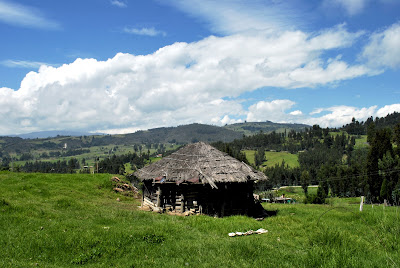People depicted in photographs (apart from media officers) are campesinos benefiting from the Oxfam's Alternative Economics initiative, which supports local farmers in growing healthier and more diverse crops, and selling them directly to consumers at fair market prices. Beneficiaries receive small funds to increase their crops' extension, and specific training to cultivate using only non-chemical fertilizers and cattle feed, according to their grandparents' techniques.
The project helps small-scale farmers earn more for their produce, while also helping ensure the availability of good quality food at affordable prices in cities. Apparently, newly re-introduced techniques increased not only the quantity, but the quality of the final product as well.
Now, for your information, a small introduction to Colombia and the so-called Rural Uribism
In Colombia, campesinos and small farmers face threats that goes from the lack of resources to access the market (land, education, health), until the limited access to technical assistance, credit and similar.
Difficulties to access land ownership include rent, distribution and entitlement-related problems: 59% of poor rural households do not own any land; in fact, there's a strong concentrating trend in the land ownership, and heavy deficiencies in entitlement management.
To tackle this issues the Colombian government adopted in 2007 a special sectorial credit policy known as "Agro-Ingreso Seguro" (AIS). Through this instrument, the government was subsidizing with special interest rates local producers. Instead of representing the solution tho campesino's problems, this policy revealed the impressive level of corruption and concentration of resources in few hands: 55% of beneficiaries received less than 1 million COP (4.812 US$); 78% received up to 10 millions (4.182 US$); on the other hand, the 1% of beneficiaries (that is to say 4 organizations and/or individuals) acceded to more than 500 million COP (240.616 US$), which is the 46% of the overall outflow.
The entity of this failure is even clearer considering that small producers represents the wide majority of agricultural producers in the country (87%) and produce around 40% of the Colombian overall basic food basket. Notwithstanding this, campesinos currently live with an average monthly income of 130 US$.
Full sources (in Spanish) are available under request.
 Now you know why he was called The shameless cat... He really tried to steal some milk in front of everybody
Now you know why he was called The shameless cat... He really tried to steal some milk in front of everybody Pre-operational briefing
Pre-operational briefing Here Simón Bolívar won the decisive battle in which Latin America acquired its definitive independence from Spanish Monarchy (Battle of Boyacá)
Here Simón Bolívar won the decisive battle in which Latin America acquired its definitive independence from Spanish Monarchy (Battle of Boyacá) Boyacá Bridge. The battle occurred here, some 150 km from Bogotá in the Andes Mountains, in a place known as Casa de Teja, close to a bridge over the Teatinos River
Boyacá Bridge. The battle occurred here, some 150 km from Bogotá in the Andes Mountains, in a place known as Casa de Teja, close to a bridge over the Teatinos River
























































2 comments:
you have such a great eye for details giulio, bellissime foto e complimenti, la tua voglia di camminare, vedere e conoscere ti sta portando in tanti bellissimi pezzi di mondo..e ne approfittiamo piacevolmente anche noi :)
Ciao Silvia!
Thanks for your comment, I love sharing what I see with other people, to nurture their curiosity and will to leave to unusual and fascinating places.
Every time someone feel like travelling with his fantasy after looking at my picture, I actually feel satisfied for what I've done!
I'm even happier when someone propose me to travel together, to be honest. :)
Post a Comment